

How to Select and Design Materials that Align to the Next Generation Science Standards. Today’s guest blogger is Joe Krajcik, Professor of Science Education and Director for the CREATE for STEM Institute at Michigan State University.
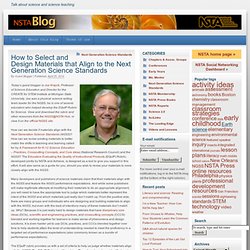
Joe was a physical science writing team leader for the NGSS; he is one of several educators who helped develop the EQuIP Rubric for Science. Position Statement: Next Generation Science Standards. I.

Introduction It is essential that all students have access to a high-quality science education that provides them with the skills and knowledge they need to be well-informed citizens, to be prepared for college and careers, and to understand and appreciate the scientific enterprise. The National Science Teachers Association (NSTA) recommends the adoption and implementation of the Next Generation Science Standards (NGSS; NGSS Lead States 2013) as an effective, research-based approach to accomplish these goals and transform science education. From health care to environmental stewardship, a countless number of personal and societal issues require citizens to make informed decisions based on their understanding of science and technology.
Today's modern workforce depends on individuals with scientific and technological skills (NRC 2010; NSB 2010). II. 1. 2. Next Generation: 5 Ways Science Classes Will Change. The millions of K-12 students who have returned to school this fall may find dramatic changes waiting in their science classrooms.
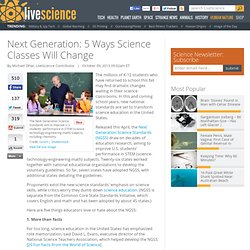
In this and coming school years, new national standards are set to transform science education in the United States. Released this April, the Next Generation Science Standards (NGSS) draw on decades of education research, aiming to improve U.S. students' performance in STEM (science-technology-engineering-math) subjects. Twenty-six states worked together with national educational organizations to develop the voluntary guidelines. So far, seven states have adopted NGSS, with additional states debating the guidelines. National Standards Update: July 2011. Next Generation Science Standards. NGSS Sci/Eng Practices. Find Your Path through the NGSS. The Next Generation Science Standards provide a framework and examples for STEM learning.
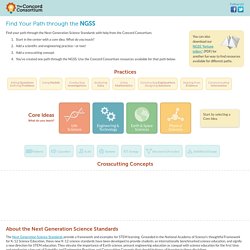
Grounded in the National Academy of Science's thoughtful Framework for K-12 Science Education, these new K-12 science standards have been developed to provide students an internationally benchmarked science education, and signify a new direction for STEM education. They elevate the importance of Earth science, present engineering education as coequal with science education for the first time and emphasize a key set of Scientific and Engineering Practices and Crosscutting Concepts that should buttress all learning in these disciplines. The NGSS hold the potential for helping focus the current national concern for improving STEM education. They will undoubtedly help bring clarity and unity to the patchwork of state standards developed throughout the standards movement in the past decades. As this occurs, innovative educational technology will be a critical component in this STEM education revolution. Search by Topics. Skip to main content.
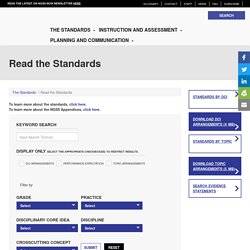
Principal: ‘I was naïve about Common Core’ Here’s a powerful piece about how an award-winning principal went from being a Common Core supporter to an opponent.
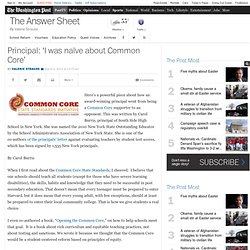
This was written by Carol Burris, principal of South Side High School in New York. She was named the 2010 New York State Outstanding Educator by the School Administrators Association of New York State. She is one of the co-authors of the principals’ letter against evaluating teachers by student test scores, which has been signed by 1,535 New York principals. By Carol Burris When I first read about the Common Core State Standards, I cheered. Why I Cannot Support the Common Core Standards. I have thought long and hard about the Common Core standards.

I have decided that I cannot support them. In this post, I will explain why. I have long advocated for voluntary national standards, believing that it would be helpful to states and districts to have general guidelines about what students should know and be able to do as they progress through school. Such standards, I believe, should be voluntary, not imposed by the federal government; before implemented widely, they should be thoroughly tested to see how they work in real classrooms; and they should be free of any mandates that tell teachers how to teach because there are many ways to be a good teacher, not just one. What It's Like on the Inside: NGSS: SSDD. Way back in May 2012, the first draft of the Next Generation Science Standards (NGSS) was released.
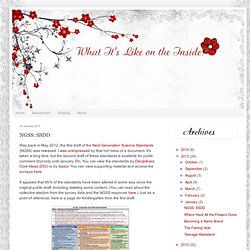
I was unimpressed by that hot mess of a document. It's taken a long time, but the second draft of these standards is available for public comment (but only until January 29). You can view the standards by Disciplinary Core Ideas (DCI) or by topics. You can view supporting material and access the surveys here. It appears that 95% of the standards have been altered in some way since the original public draft, including deleting some content. What Makes a Standard a Standard? New Science Standards: Bound for Glory, or Running Behind? Published Online: May 23, 2012 Commentary By Arthur H.

Camins Physics teaches us that speed, acceleration, direction of movement, and time are all relative to a reference point. This principle, related to objects and motion, is worth considering as a metaphor for education policy. A life worth Achieving, Inc. The process of science has not changed much the past few hundred years.
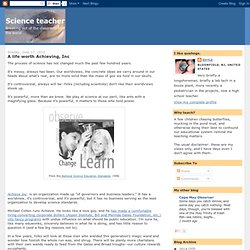
It's messy, always has been. Our worldviews, the concrete ideas we carry around in our heads about what's real, are no more solid than the mass of goo we hold in our skulls. It's controversial, always will be--folks (including scientists) don't like their worldviews shook up. It's powerful, more than we know. We play at science at our peril, like ants with a magnifying glass. Achieve Inc. is an organization made up "of governors and business leaders. " Michael Cohen runs Achieve. Draft of Common Science Standards Draws Friendly Fire - Curriculum Matters. The first public draft of common science standards is encountering some criticism from a prominent teachers' organization and a Washington-based think tank, with the former complaining of a "lack of clarity and coherence" in the performance expectations, and the latter saying the draft serves up an overdose on scientific "practices" while omitting some key content knowledge that it argues needs to be explicitly included.
In both instances, the feedback is essentially a "critical friend" approach, as the National Science Teachers Association is a partner involved in the development of the standards (and as such, has been privy to earlier, private drafts), and the Thomas B. Fordham Institute is a strong advocate for producing common science standards. "The quest for fewer standards has led to overcompression, overgeneralization, and omission," write Fordham's set of seven expert reviewers, led by Paul Gross, a professor emeritus of life sciences at the University of Virginia.
Next Generation Science Standards: Lost in Space? « Big Rock Blog. Please note (April 11, 2013): The following blog post was written after reading the first draft of the Next Generation Science Standards last year. I have since been involved in multiple feedback sessions, and it has been gratifying to see how our feedback has been used in the final standards–I am now quite supportive of them. May 2012 Blog Post: I had high hopes for the national Next Generation Science Standards. Still do. Excitement around a strong set of science standards could guide teaching and learning, promote collaboration, and lead to reasonable assessment.
However, after spending time reviewing them and talking with colleagues, my concerns are growing greater all the time. 1. In addition, the assessment boundaries themselves leave me concerned. Science Standards: The Next Generation. Yes, it’s true. The Next Generation Science Standards are available to review. You can submit feedback on the standards as they are until June 1. I can’t stop thinking of Star Trek: The Next Generation when I read these. Help me. A Science Teacher's View: The Backward-Engineered Common Core Science Standards - Living in Dialogue. NGSS: Meet the new boss. This is too much science for one post-- I'll get around to splitting it up but wanted to toss it out there now since we only have 3 weeks to comment on the proposed standards. Meet the new boss Same as the old boss I've started plowing through the Next Generation Science Standards draft.
We, the public, have all of three weeks to comment on a document so confusing it comes with an article and a video on how to read the document. When you get to the document, you get 87 pages of color-coded (at least 9 shades at my count and I'm color-blind) jargon with DRAFT splashed across each page. You don't have to get too far, though, to find subtly major problems, the kind that condemn elementary school kids to a lifetime of ignorance. Chemical reactions produce new substances; physical changes do not. Sponges are animals, too. And they don't "move around. " My sophomores think "animal" means something warm, fuzzy, and mobile. NGSS.